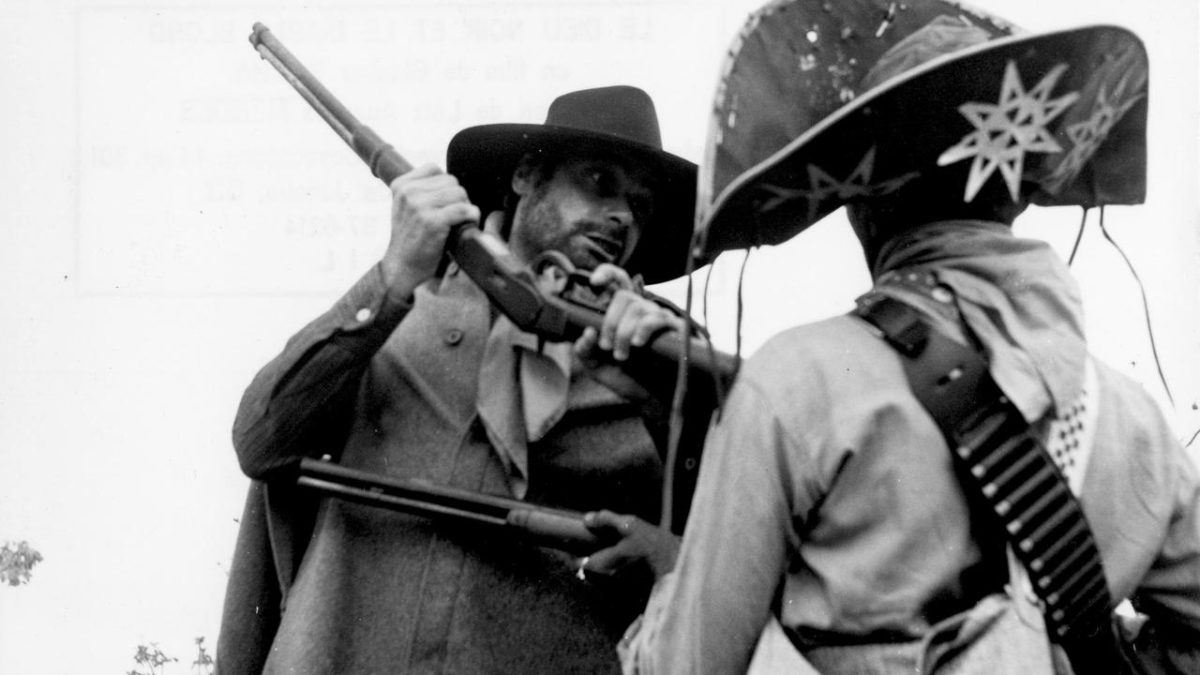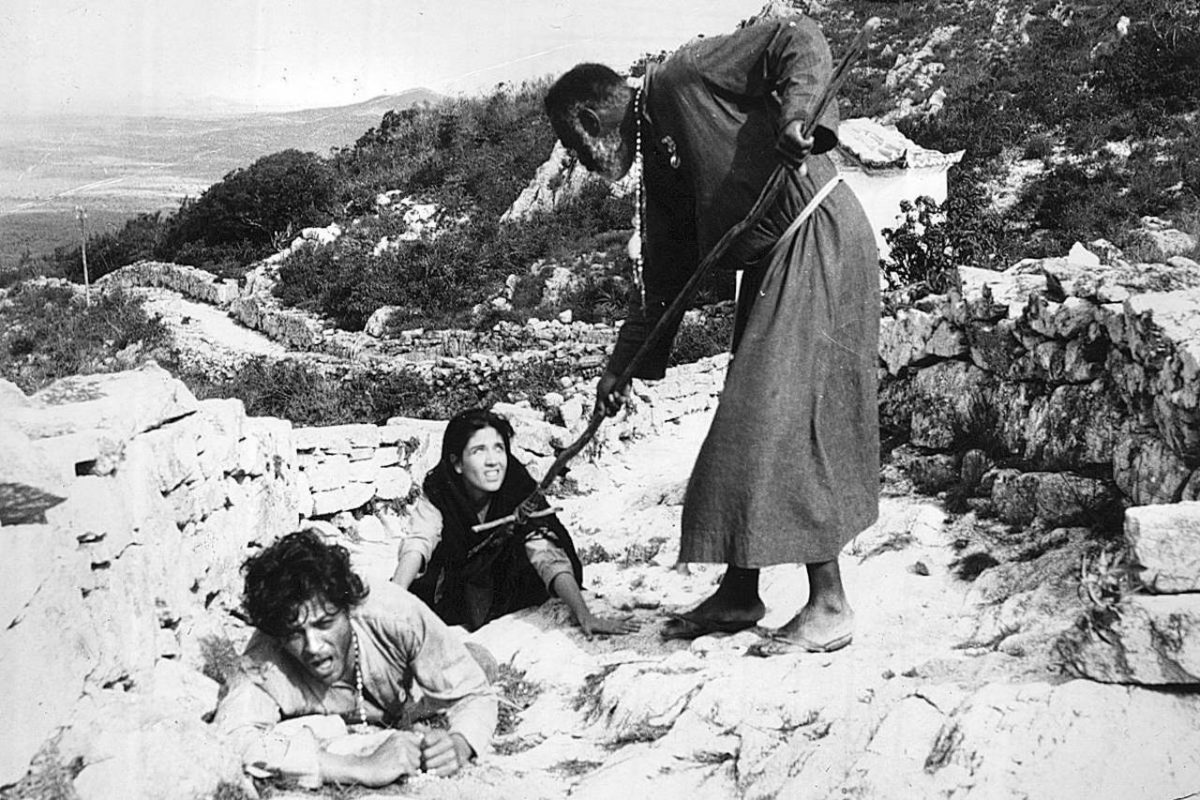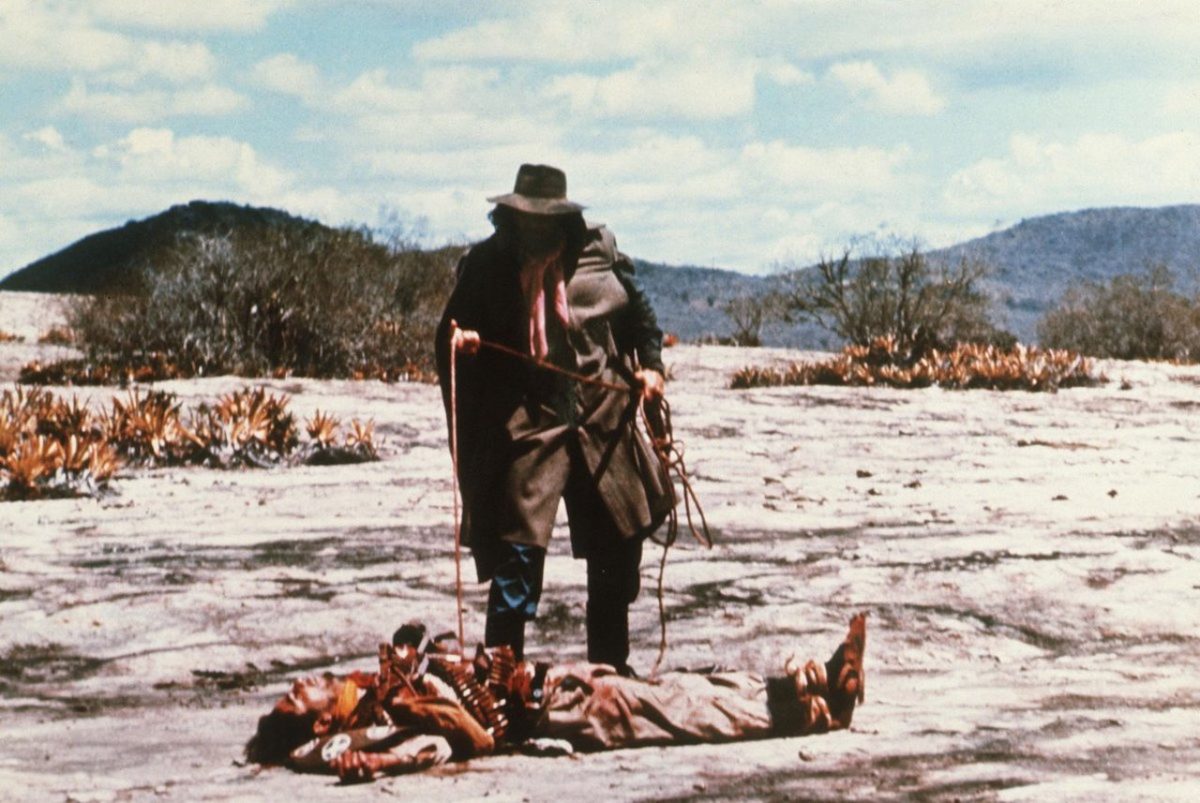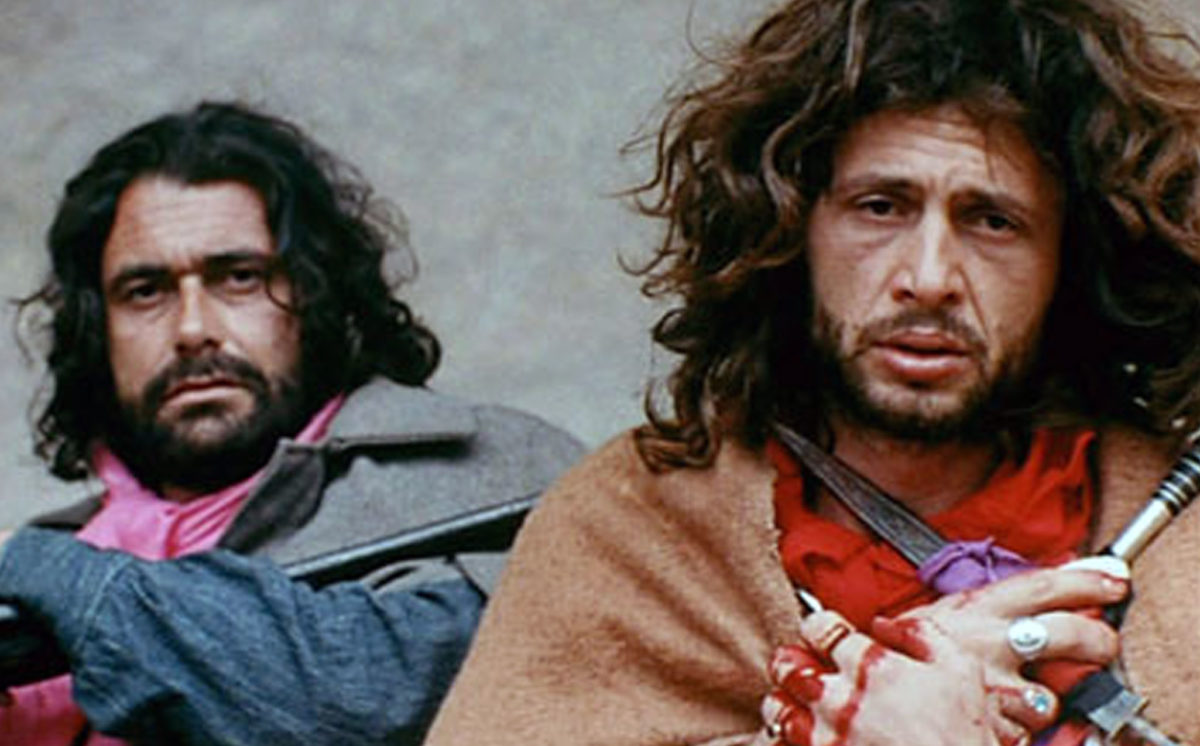“The Earth belongs to man, not God or the Devil,” reads the defining line of Brazilian auteur Glauber Rocha’s 1964 feature Deus e o Diabo na Terra do Sol (Black God, White Devil). Within the fiction, said phrase reaffirms the potential for self-determination of ranch-laborer-turned-outlaw Manoel (Geraldo Del Rey); a path other than the devious religious dogmas we see him desperately cling to in his quest for any kind of solace. He’s come to understand that, until something is done about it, the arid landscapes of the Northeastern sertão will remain indifferent to human injustice. No matter how exploitative and cruel the landowners’ antics are, or how loud the screams for mercy can be, everyone in this forsaken backcountry remains stagnant, waiting for some abstract external force to potentially make things better.
Naturally, the materialistic worldview in question exists as an extension of Rocha’s own militancy. The often referenced author of the manifesto The Aesthetics of Hunger (1964) believed in a radical cinema birthed from the bursting rage of the historically oppressed. The medium’s formal foundations needed to be retooled as blunt instruments for socio-political liberation; weaponized against the complacent forces of the imperialist ‘First World’ entertainment industry.
Manoel’s arc towards emancipation is deeply rooted in the harsh realities of peasantry in mid 20th century Brazil, while simultaneously reflecting one of Cinema Novo’s overarching goals in the prevailing rejection of longstanding hierarchical structures. Just like enigmatic and principled mercenary Antonio das Mortes (Maurício do Valle) freeing Manoel from the will of the cangaçeiros, the movement saw itself as a facilitator of sorts, a symbol of deliverance that cleared the way for novel avenues of exploration and new popular understandings.

This entrancing future of revolutionary possibilities was to be rooted in the realms of men, in all their unflinching agony and stark contradiction. Neglected figures were the ones to take the spotlight with their tales of affliction; mobilizing as their visceral anger leapt from the screen. To rightfully portray these primal urges, archaic acting methods and affectations had to make way for something rawer. A sharper route had to be carved out even beyond the limits of naturalism.
Cinema Novo’s answer to this latter pursuit tends to be characterized through the reductive lens of European influence: a tropical amalgamation of Nouvelle Vague’s kinetic style and Italian neorealism’s humanist candor. Needless to say, such broad stroke representation forgoes the movement’s inherent heterogeneousness. There were indeed shared intellectual and aesthetic concerns linking together a wide net of non-conforming filmmakers, yet their frontal rebuff of any kind of dogmatic approach also meant a scattered stylistic landscape, even with regards to interpretation; a wide array of expressive forms where Nelson Pereira Dos Santo’s sober lyricism and Joaquim Pedro de Andrade’s offbeat satirical caricatures could stand next to Rocha’s hectic ensembles.
Personal disposition wasn’t the only differentiating factor, either. As it goes in the chaotic timeline of Latin American history, abrupt political recasting tended to reshape the socio-cultural environment and put artistic intent in a state of constant flux. That usually meant reassessment within the same movements, the same bodies of work, and at times, even the same ideas and characters. The revolutionary forms couldn’t risk inertness. Despite external aesthetic appreciation and international alliances, their essence still resided in a confrontational relationship with their own environment. If the piercing shrieks of their subjects were to be met with numbness, a new way to showcase them was required. After all, the whole point was to make them unbearable, to strike us into change by making “this hunger felt but not intellectually understood,” as Rocha famously stated.

Just as Manoel’s climatic sprint towards potential liberation cuts to the overwhelming vastness of the ocean in the final seconds of Deus e o Diabo na Terra do Sol, a fraudulent aura begins to loom over the sequence (at least for its so-called intended audience). Geraldo Del Rey’s strides are frenzied and urgent, and DP Waldemar Lima’s camerawork never compromises its grimy ethos, even as the whole climax is inextricable from Rocha’s earnest idealism. Once Democratic President João Goulart was removed from office by way of a military coup later that year, the buy-in for folk “champions of the people” like Das Mortes had essentially vanished.
As the audiovisual embodiment of The Aesthetics of Hunger (released shortly afterwards), Deus e o Diabo na Terra do Sol epitomized the filmmaker’s worldview in the way it approached the bodies on screen. Distressed visages and semi-catatonic physical states are a constant sight in Manoel’s brutal odyssey of disillusionment. Rocha believed in violence as the only pathway towards deliverance for those deemed helpless, and the way every cast member is directed shows he didn’t only mean that in terms of insurrection.
There’s a non-stop intensity in every performance that manages to sneak into the frame; a hyperbolic sense of desperation that catapults the film’s reality into an almost fable-like endeavor. The only exception is the stoic outlaw played by Maurício do Valle. His distinctive poise signals an almost peripheral existence in relation to the world at hand; a living mythical anti-hero springing directly from Brazilian popular culture’s fascination with the jagunços and cangaçeiros (roughly South American equivalents of the vigilantes and bandits of the Old West). The question then became: if there was a place for these modern libertadores and their miserable-but-galvanized followers in the context of an authoritarian state, to whom were these performances actually speaking to, after Cinema Novo’s reputation collapsed? Rocha’s answer came in the form of 1969’s O Dragão da Maldade contra o Santo Guerreiro (Antonio das Mortes), a sequel to Deus e o Diabo na Terra do Sol now totally devoted to the phlegmatic mercenary.

From the get-go, the transition from the barren black and white landscapes of the sertão to a high-contrast technicolor rendition of humble town Jardim de Piranhas evidenced a significant shift in Rocha’s aesthetics. Once the film catches up with Das Mortes, the mythological agony that defined all screen presence in his previous work is dialed back to the point of quasi-oratorical affectation. Just in the first couple of minutes, a character recapitulates Das Mortes’ previous adventure with a veneer of historicity, which is later followed by a poetic soliloquy, directly facing the camera, by whom will soon be disclosed as one of the film’s antagonists. The whole theatrical pretense even extends to Do Valle’s cryptic anti-hero, who can be seen sharing introspective ruminations while looking out to the horizon.
It might sound counterintuitive at first, but Rocha’s newfound embrace of artifice and ostentation, in both form and performance, actually came as a result of his own acknowledgement of Deus e o Diabo na Terra do Sol’s romanticism. In the context of the military regime’s draconian censorship, the whole landscape of Brazilian arts found itself turning away from direct conflict towards a more esoteric kind of dissent, one that saw the previously condemned imperialist cultural strategies as possible pathways towards wider popular impact. For Rocha, that meant retooling his abrasiveness by way of recontextualization. The bright colors and baroque interpretations sold a facade of accessibility quickly brought down by anyone who actually engaged with his eclectic Tropicalist desolation.
In O Dragão da Maldade contra o Santo Guerreiro Antonio das Mortes is finally depicted as a fully fleshed-out character, yet contrary to expectation, this ends up stripping him of any and all heroism. Do Valle takes every opportunity to extoll the brooding nature of the iconic matador de cangaçeiros: he limps from confrontation to confrontation, always emphasizing the nagging fretfulness of a reluctant protagonist. Unlike his previous stand-off, he now works for the good guys, finally reasserting himself as the muscle of the oppressed, but there’s little elation in the climactic finale this time around. The bloodbath is relentless; exhausting, even. It concludes, and there’s no glorious stroll towards the sunset this time around, just a fallen hero staggering clumsily towards the nearest gas station. For Rocha, Antonio’s last few steps embody a movement and country’s transmutation.
